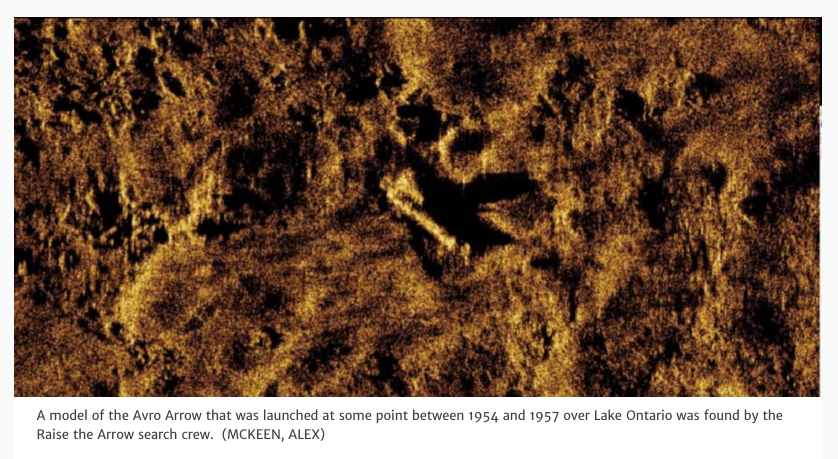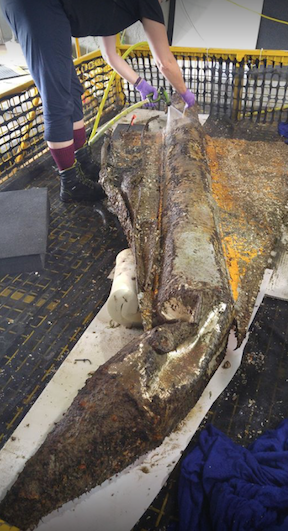
Search crews have recovered a test model of the Avro Arrow on the floor of Lake Ontario.

Canada’s Avro Arrow Interceptor, 1958 to 1959.
The Avro Arrow, a sleek jet interceptor was developed in Malton, Ontario and had the potential to propel Canada to the forefront in military aviation. The Arrow had its first flight on March 25, 1958 and was built to intercept Soviet bombers that might have entered North American airspace over the North Pole during the Cold War. Built by A.V. Roe Canada, Arrow was a good aircraft, but a costly one. When the program was abruptly cancelled in 1959 by Prime Minister John Diefenbaker, more than 30,000 employees lost their jobs, and the planes and all related materials were ordered to be destroyed. "Cut up with torches, hammered down with steel balls like they destroy buildings," described a photographer who rented a plane to take footage of the destruction, since media were not allowed in the facility.
THE SEARCH
Lying deep in the depths of Lake Ontario are the remains of at least nine Avro Arrow models launched in the mid-1950s. The magnesium one-eighth scale models were shot off atop rockets to test aerodynamics and were loaded with radio and telemetry gear. They were launched over the lake atop Nike booster rockets, allowing them to break the sound barrier. “A Nike booster would fire it up to speed at about Mach 1.7, and then the model would carry on,” said Dr. Richard Mayne, the Royal Canadian Air Force’s senior historian.
They were left in the water and never found despite several searches.

THE SEARCH
A collaborative effort by several private companies was assisted by the Canadian Coast Guard and the Royal Canadian Military Institute to bring up the only known artifacts of the Avro Arrow program. The group "Raise the Arrow" located two different models on the floor of Lake Ontario, off Prince Edward County, in 2017. Project Manager John Burzynski, president and CEO of Osisko Mining leading the search team.
OEX Recovery Group, which is spearheading the "Raise the Arrow" expedition, says that new sonar imagery located the artifact, a grand-father of the magnesium Avro Arrow free-flight models.
The mission ran the underwater sonar equipment for eight hours a day, after which the data was downloaded and analyzed by the team of scientists and archeologists. They searched an area about 64 square kilometres. The search grid covers water ranging in depth from five metres closer to shore and 100 metres farther out in the lake. The expedition spent a total of 12 days since the end of July searching the lake.
A Newfoundland company, Kraken Sonar Systems, was awarded the $500,000 contract deploying its state-of-the-art ThunderFish underwater vehicle and AquaPix sonar system to capture high-quality images of the lake bed. Kraken Sonar Systems provided an unmanned, untethered automated underwater vehicle to assist in the search.
THE RECOVERY
What they recovered is one of several different models which were launched for testing the delta wing design, the triangular shape that the plane was known for, at supersonic speeds. The test was conducted at such a high speed that the nose of the model was bent when it hit the water.


CONSERVATION AND EXHIBITION
As conservationists and historians, Koolen Fine Arts was invited to an unpublished call to attend the harbour at Canadian Forces Base Trenton, to witness the landing of the first recovered artifact from the "Raise the Arrow" mission.
Canadian Conservation Institute had been tasked with preparing a conservation plan for the recovery of these models and booster rockets. When recovered, each artifact will receive the appropriate conservation work to stabilize it during recovery operations, before more in depth treatments in Ottawa. A bay in the 8 Wing dock facilities had been set up by the Canadian Conservation Institute to receive the recovered items.
The barge ferrying the cradled artifact handed it over to Elizabeth Joy of Canadian Conservation Institute where it was unveiled from its dampened covers. The Commander of the Canadian Army as well as the Chairman of the Board of the National Air Force Museum of Canada were present to witness the landing.

Canadian Conservation Institute temporary conservation laboratory at CFB Trenton

Corporate, Military and private reception of the Avro Arrow Program Artifact , August 2018



The Avro test-model recovered from the bottom of Lake Ontario, August 2018
The models discovered by the search team will find new homes at the Canada Aviation and Space Museum in Ottawa and the National Air Force Museum of Canada in Trenton, Ontario.
The "Raise the Arrow" expedition, Burzynski said, was not only about finding something that was lost. It was about the people who worked on the plane, and all the Canadians who held dear the memories of the Arrow. Canadians were stunned when then-prime minister John Diefenbaker announced the cancellation, the reasons for which were never clear, but likely had to do with costs. "There was such a brain drain in Canada because we lost such a core of our aerospace industry," said Erin Gregory, a curator with the Canada Aviation and Space Museum. "It resonates with people through the years."
Hope is that our country is beginning to gain back some prestige in the field of science and technology.

The initial Chief Test Pilot of the Avro Arrow was Janusz Zurakowski. He was a friend of Koolen Fine Arts and autographed many photographs of the Avro Arrow which have been donated to many charities for auction over 20 years.
Koolen Fine Arts *53 Downie Street, Stratford, Ontario, N5A 1W7*